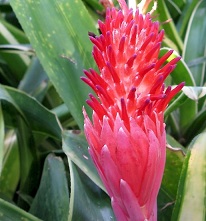In January, 2016, I moved back to Florida from another southern state. It was great to see familiar plants and to be able to go to the beach again.I love the dizzying varieties of beautiful bromeliads, but could definitely live without the mischievous mosquitoes!
Those mischievous mosquitoes
Shortly after arriving back in Florida, the mosquito-borne “Zika” virus started making headlines. The Aedes aegypti and Aedes albopictus mosquitoes, which can be a vector (carry) Zika, had people purchasing insect repellent, covering limbs, and trying to eliminate all standing-water, the common source of these little critters.

There are videos of work crews and paranoid homeowners pulling bromeliads from their landscape beds. Some of the most gorgeous plants were harshly ripped up and thrown away to try and eliminate breeding grounds for all mosquitoes.
According to the University of Florida IFAS Extension “Florida Resident’s Guide to Mosquito Control“, there are eighty different species of mosquitoes living in Florida. And only five of those can carry and transmit diseases dangerous to humans and animals. While those mosquitoes will lay their eggs in any standing water, the mosquitoes which are typically found in bromeliads in Indian River County, Wyeomyia smithii, neither bite humans nor vector diseases transmitted to humans. But if you are still unsure, you can sprinkle a granular product containing Bt (Bacillus Thuringiensis) into your bromeliad’s water holding leaf bases to control the insects and keep those bright shade plants.

5 thing to know about Bromeliads
If you still have or are considering purchasing some of these gorgeous, low-maintenance plants, here are 5 things you should know:
- Bromeliads are not parasites. They will not harm the other plants to which they are attached or under which they are planted.
- They are an easy-care way of adding color and interest in shady spaces. Light-colored leaves brighten up the under-story. There is a bromeliad for all light conditions..
- Bromeliads are NOT a major source of the Aedes aegypti mosquitos which can transmit diseases, like Zika. They often are home to tiny frogs and lizards which will eat any insects found in and on the plant.
- They come in many colors from cool shades to hot vibrant yellow and red.
- Bromeliads flower, then produce off-set “pups”, with the original plant dying all within a one year span.
Looking for something specific? Join the local Bromeliad Society, 
The bloom stalk of the urn plant bromeliad is like a spiky pink scepter, Photo by Yvonne Florianhttp://www.irbromeliadsociety.org/membership.html.
Bromeliad specimens for Indian River County
Aechmea fasciata is also called “Urn Plant”. It’s pale green leaves are strikingly tiger-striped in a soft white. Their scepter-like bloom stalks shoot up from the center on a pink stalk and are long-lasting with pink spikes around the purple tubular flowers.

Neoregelia Carolinae usually has longitudinally striped leaves and blushes a bright fuchsia-red in the center when it is ready to bloom. Its little purple, tubular blooms are down in the central cup or “pitcher” of the plant.

Guzmania spp. are perfect for DEEP shade or as a houseplant. Their leaves are soft and cannot take any direct sunlight. Flower bracts on the bloomstalk can be yellow, red, or fuchsia with white, deep purple or cobalt tubular flowers.

Billbergia spp., most common variety around Vero Beach is nicknamed “Hurricane plant” because its short-lived bright red bloom stalks coincide with end-of-summer heavy rains. This one will climb up your oak trees for some interest in the landscape. The lime green leaves brighten up shady spots the rest of the year.

Anana spp., is the pineapple. The fruits of this ornamental red variety are edible though not much flesh is left after trimming away skin and core. There is also an all green variety. Plants will produce more than one fruit in a season.
For more research based information on bromeliads in your home landscape, please visit the University of Florida’s EDIS topic page on Bromeliad publications.
To learn more about Mosquitoes in Florida and how to prevent their swarms, please visit the topic page of UF’s EDIS Mosquitoes publications.
 0
0
